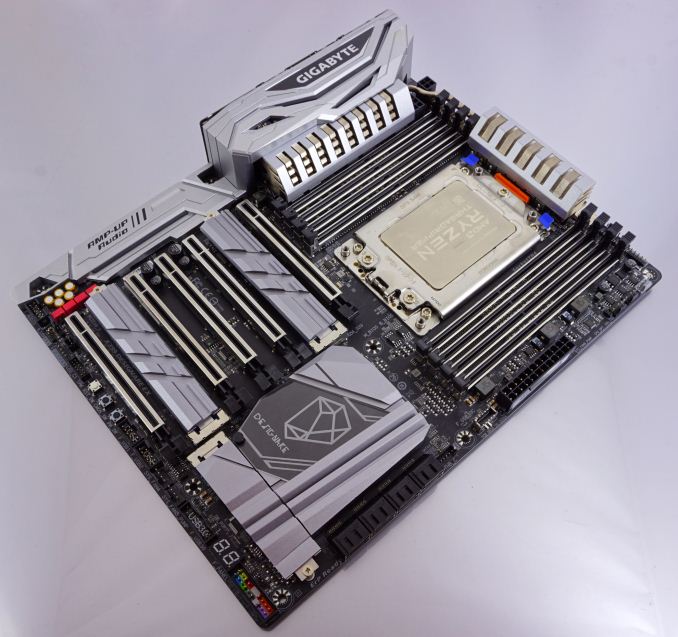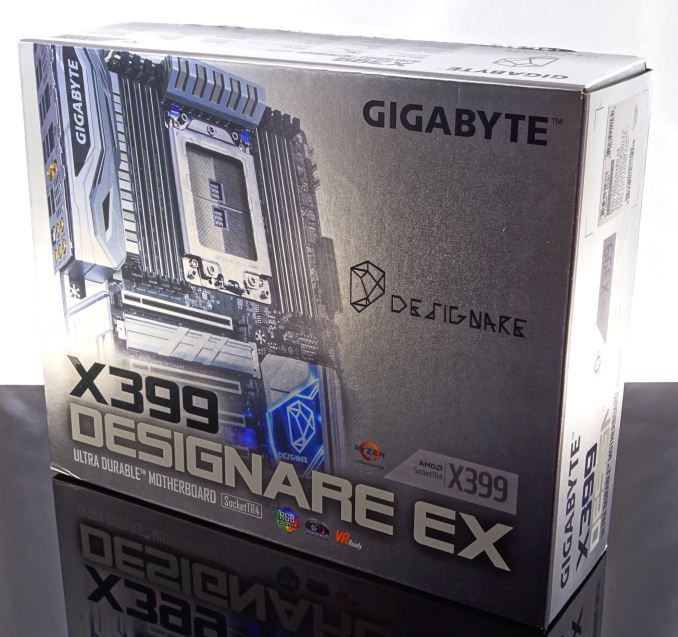The GIGABYTE X399 DESIGNARE EX Motherboard Review
by E. Fylladitakis on June 22, 2018 11:30 AM EST- Posted in
- Motherboards
- Gigabyte
- ASRock
- Asus
- Ryzen
- ThreadRipper
- X399
- 1950X

Even now, almost a year after the launch of the Ryzen Threadripper processors by AMD, there are only a few X399 motherboards available in the market. Threadripper aims for the top end of the enthusiast and workstation market, and comes with a price tag, therefore it is only natural that motherboard manufacturers would not expend much of their resources on such a limited market. As a result, GIGABYTE only offers two motherboard options to date: the gaming-focused AORUS X399 Gaming 7 and the feature-packed X399 Designare EX, but we do know that an X399 Aorus Extreme is also set to be released in the near future. In this review, we are having a look at the X399 Designare EX, the current GIGABYTE Halo implementation of AMD's X399 chipset.
The Designare EX is the most expensive and feature-packed motherboard GIGABYTE has to offer, yet its features seem to have been selected with productivity in mind. For example, gaming-specific features such as an Intel E2500 Killer LAN gaming chipset are implemented on the cheaper AORUS Gaming 7 motherboard, yet not on the Designare EX, instead going for dual Intel networking ports and Wi-Fi. As its name hints, GIGABYTE is probably targeting this motherboard more towards professionals and designers.
AnandTech's AMD Ryzen Threadripper and X399 Motherboard Coverage
- The AMD Ryzen Threadripper 1950X and 1920X Review: CPUs on Steroids
- An AMD Threadripper X399 Motherboard Overview
- Analyzing Threadripper Thermals: Big Base Cooling Wins
- AMD Reveals Threadripper 2 : Up to 32 Cores, 250W, X399 Refresh
- GIGABYTE’s X399 Aorus Extreme: The Threadripper 2 Halo Motherboard
- New EKWB Threadripper X399 Monoblocks for GIGABYTE and MSI
GIGABYTE X399 Designare EX Overview
The GIGABYTE X399 Designare EX is a motherboard designed to be both feature-packed and reliable. Its list of features is very long and, despite the massive size of the processor's socket and the eight DDR4 RAM slots, the dimensions of the GIGABYTE X399 Designare EX are exactly those of a typical ATX motherboard, allowing it to be installed inside any typical ATX-compliant case.
A quick glance at the motherboard's specifications reveals that up to eight SATA drives and three M.2 drives can be connected on the GIGABYTE X399 Designare EX. The motherboard does not have a U.2 drive connector, making GIGABYTE the only manufacturer who did not add one on their top-tier AMD X399 motherboard. However, GIGABYTE supplies a U.2 to M.2 adapter, allowing the connection of a U.2 drive onto any of the motherboard's three M.2 slots. The motherboard also has a massive number of USB 3.1 Gen 1 ports and there are also two USB 3.1 Gen 2 ports, one Type-A and one Type-C.
In terms of connectivity, the motherboard has dual Intel I211-AT Gigabit LAN controllers, plus an Intel 802.11ac/Bluetooth 4.2 wireless adapter. The I211-AT are renowned for their efficiency and stability (and it is not bad for gaming either). The wireless card supports speeds up to 867 Mbps.
GIGABYTE heavily advertises the audio capabilities of the X399 Designare EX, focusing on the Creative Sound BlasterX 720° support. Note that Sound BlasterX 720° is not a chipset but a software package that is designed to work with any compatible chipset/motherboard. Realtek supplies the well-known ALC 1220 audio chipset that also has an integrated smart headphones amplifier.
One of the truly unique features of the GIGABYTE X399 Designare EX is the presence of a fifth full-length PCIe slot. Like every other AMD X399 motherboard, the GIGABYTE X399 Designare EX has four PCI Express slots that are directly connected to CPU lanes (×16 / ×8 /×16 / ×8), but right in the middle of these four slots, the Designare has an added a fifth full-length PCI Express slot with four lanes connecting to the chipset.
The second important feature of the GIGABYTE X399 Designare EX is the implementation of an International Rectifier IR35201 digital controller. What is unique about this particular controller is that it implements an algorithm that balances the load (and the heat output) across all of the power phases. This means that instead of having a couple of stages heavily loaded all of the time while the rest are idling, all eight stages are continuously sharing about the same load, greatly increasing the longevity of the circuitry. This means that the motherboard should hold up well for the upcoming Threadripper 2 launch.
Overall, the X399 Designare EX is a motherboard that seems to be leaning more towards professionals. There are gaming-related features, such as RGB lighting and support for external RGB strips, but these are more of an exception rather than the rule. The company refrained from adding gaming-focused chipsets or complex/untested circuitry, sticking to heavily tested and proven choices. As we will see in the following pages, GIGABYTE also focused on the cooling capabilities and the physical strength of the motherboard a lot as well, hinting that the X399 Designare EX has been developed in order to please users who seek stability and reliability above all else.












20 Comments
View All Comments
Oxford Guy - Sunday, June 24, 2018 - link
I agree. When TR 2 hits I would highly recommend Anandtech do an "undervolting Threadripper" page that compares Gen 2 an Gen 1 — on multiple boards.And, since this is a pro product, the overclocking stability threshold needs to ensure real stability, not the quick and dirty standard.
ECC RAM would also be useful to look at, when analyzing TR 2.
azrael- - Wednesday, June 27, 2018 - link
I was just going to point out that one of the foremost features on what is a semiprofessional motherboard for AMD's ThreadRipper should be support for ECC memory and the subsequent test thereof. Luckily, as far as Gigabyte's specification table goes the motherboard *does* support ECC memory. Now AT only needs to test it.Tom S - Monday, February 24, 2020 - link
I know that this is not a conclusive test, but with my X399 Designare EX...I have 4X16GB sticks of Kingston KSM26ED8/16ME - 2666GHz - ECC - CL19 - 1.2V
When I OC'd the memory to 3600MHz @ 1.2V with very tight timings (I forget exactly what)
it threw an ECC error that was captured by Memtest86.
Other ECC boards I've owned, have reported ECC errors in Windows event log "Kernal-WHEA",
or another log viewable in BIOS.
hansmuff - Saturday, June 23, 2018 - link
Which program did you use for measuring DPC? There are a few different ones, and I find they all produce different results.CEH - Monday, June 25, 2018 - link
You seem a bit obsessed with AMD lately. Isn't there anything interesting in Intel-related boards?oleyska - Tuesday, June 26, 2018 - link
I'll throw this out there:No..
Z170->270->Z370 is similar with minor updates to bling and the vrm circuit but nothing exciting.
X299 apart from evga's isn't very interesting.
The thing that makes x399 very exciting is the 64(60) pci-e lanes exposed to board manufactures while Intel have been giving 20,28,44 forever!
crashtech - Tuesday, June 26, 2018 - link
Flash drive instead of DVD should really be doable at this price level for sure.zukefok - Wednesday, June 27, 2018 - link
A quick glance at the motherboard's specifications reveals that up to eight SATA drives and three M.2 drives can be connected on the GIGABYTE X399 Designare EXvirpuain@gmail.com - Sunday, July 15, 2018 - link
"The second important feature of the GIGABYTE X399 Designare EX is the implementation of an International Rectifier IR35201 digital controller. What is unique about this particular controller is that it implements an algorithm that balances the load (and the heat output) across all of the power phases. This means that instead of having a couple of stages heavily loaded all of the time while the rest are idling, all eight stages are continuously sharing about the same load, greatly increasing the longevity of the circuitry. This means that the motherboard should hold up well for the upcoming Threadripper 2 launch."The IR35201 is not the reason any board will fulfill the power delivery needs ofa TR2, fets and phases will.
That being said, eight real phase consisting of the IR3556 is subpar VRM for a motherboard that needs to handle cpus at the 200W range. Board is pricey, in fact the VRM on this board is weaker than what you have on the flagship AM4 boards, like the taichi or ASUS CVII.
Tom S - Monday, February 24, 2020 - link
Did you run this with a special BIOS?I am trying to enter an offset voltage, but my BIOS F12, and every reviewer post that I've seen
seems to have Dynamic Vcore(DVID) and Dynamic VCORE(DVID) for SOC grayed out.
Is there some other field that I need to set in order to enter a value here? Help someone, thanks.